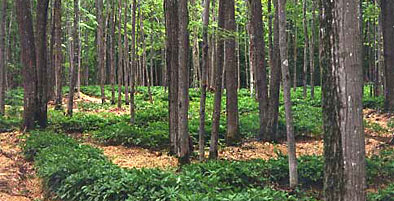University of Maine’s Agriculture and Non-Timber Forest Products Professional, David Fuller, explains what an ostrich fiddlehead looks like and how it compares with its toxic cousin, the bracken fern. When harvesting fiddleheads, it’s extremely important to choose those from the ostrich fern which are characterized by a hairless, smooth, deep green stem that has a deep groove on the inside. The fiddleheads have a brown, papery substance on the outside of the unfurled frond called ramenta. Ostrich fern fiddleheads should be picked before they unfurl and become tough.
Ostrich fern fiddleheads tend to grow near alluvial flood plains where there is adequate moisture, yet they can be found in zones 3 through 6 and are widely adaptable. Silver maple, bloodroot and trout lily are all indicator species, meaning that fiddleheads may be found within the same ecosystem. In addition to location, David Fuller also discusses the time of year in which fiddlheads can be harvested. Once the fronds unfold, they are no longer considered edible, thus harvesting while they are still tightly coiled is best done in early spring soon after forsythia and daffodils begin blooming.
Dave Fuller, University of Maine’s Agriculture and Non-Timber Forest Products Extension Professional, explains the two different ways in which the ostrich fern fiddlehead reproduces. One method of reproduction involves spores, which the fertile frond produces. The other method is through the rhizome which sends up ‘daughter plants’. These daughter plants spring up around the parent plant with new growth that is then harvested as the fiddlehead. Ostrich fern fiddleheads could be propagated for forest farming but the best method would be via tissue culture which is fairly expensive. Fiddleheads are still plentiful enough to be a wild-managed crop, but forest farming fiddleheads could become a more viable option contingent on the cost of producing via tissue culture.
David Fuller explains the necessity of sustainably harvesting wild edibles like ostrich fiddlehead ferns. A sustainable harvest would entail taking no more than half of the fiddleheads from each plant. This practice allows the ostrich fern to reproduce and produce more fiddleheads the following year. When harvesting on private land, it’s important to ask the landowner’s permission before taking any plants and it’s considered good etiquette to offer a portion of any harvested products to the landowner. Over-harvesting ginseng, for instance, has led to a ban on harvesting the medicinal herb in some states. Stewardship is critical to ensure that these plants survive and can be harvested for generations to come.
The Farmington, Maine Fiddlehead Fern Festival is an annual celebration of local food. Homegrown produce and foraged wild edibles, namely the fiddlehead ostrich fern, are featured in a variety of tasty plates dished up at the festival. The University of Maine’s Agriculture and Non-Timber Forest Product Extension Professional, David Fuller, gave a walk-and-talk, in which he shared his knowledge of the fiddlehead ostrich fern and promoted the practice of sustainable harvest to insure a healthy population of fiddleheads for years to come. Live music, dancing and good food bring the community together for a celebration of fiddlehead ferns.
President of NorCliff Farms and its sister company, Produit de Nos Bois Inc, Nick Secord, explains the misconception that ostrich fiddlehead ferns are toxic. While other ferns, such as the bracken fern are carcinogenic, the ostrich fiddlehead fern is edible once cooked and has a high nutritional value. Reports of illness after consuming ostrich fiddleheads have prompted research on the matter. Nick explains how the alluvial flood plains in which ostrich ferns are commonly found are also conducive to bacteria which is swept in from flooding river water that in turn covers the fiddleheads and could possibly coat them with harmful microbes. After a thorough steaming or boiling, the ostrich fern fiddleheads are effectively sterilized and are safe to consume.
NorCliff Farms, the Corporate Headquarters in Ontario, Canada and their certified fiddlehead plant location in Quebec, Produits des Nos Bois, make up the largest producer and distributor of fiddlehead ferns in North America. This is a good example of how large forest farming can become when sustainably harvested and managed. The ostrich fiddlehead fern is edible when the frond is still unfurled. It is at this point that it is harvested, inspected, washed and packaged at the plant in Asbestos, Quebec.
